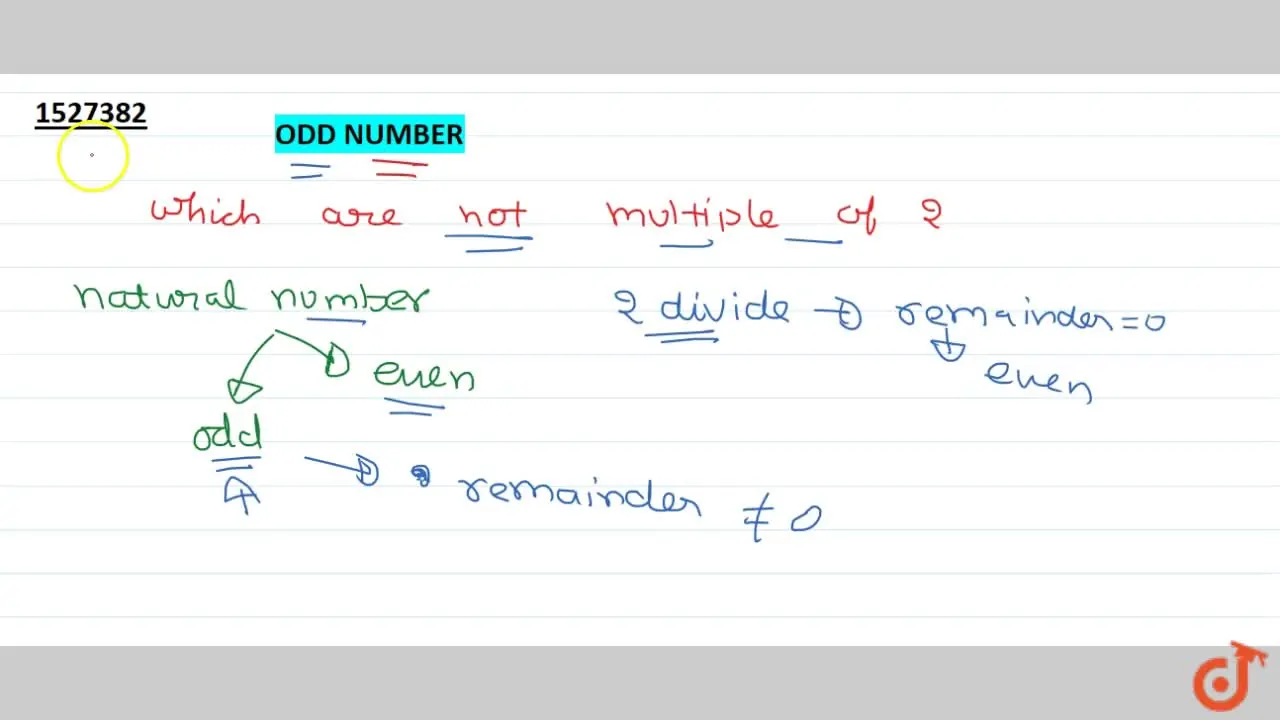ODD NUMBERS Numbers which are not multiples of 2 are called odd numbers.
Odd Numbers
Odd numbers and even numbers play a very important role in the field of mathematics. One needs to have a clear knowledge in the best way. In this chapter, we will study odd numbers. We will also have a look at the solved problems of the odd number to get a good and clear idea about it.
What are odd numbers?
The numbers which are not multiples of 2 are called odd numbers. It can be explained that the number form 2k+1 is called an odd number where k ∈ Z (i.e. integers). When it comes to the set or numbers of integers on a number line, it can either be even or odd. Let us have a look at more key points as under:
- An odd number which is an integer cannot be multiplied by 2.
- The remainder or result when these numbers are divided by 2 should be a fraction or 1.
- In the case of the number line, the first positive odd number is 1.
Odd numbers chart
Here in the below chart, you can have a look at the odd numbers from 1 to 100
1
11
21
31
41
51
61
71
81
91
3
13
23
33
43
53
63
73
83
93
5
15
25
35
45
55
65
75
85
95
7
17
27
37
47
57
67
77
87
97
9
19
29
39
49
59
69
79
89
99
Odd Numbers list
It should be noted that from 1 to 50, there are 25 odd numbers, and from 1 to 100, there are 50 odd numbers. Further, there are 500 odd numbers in case of numbers from 1 to 1000 where there are 500 even numbers.
Number Range
No. of Odd Numbers
1 to 50
25
1 to 100
50
1 to 1000
500
What are the properties of odd numbers?
There are four main properties which are related to their addition, subtraction, multiplication and division. We will discuss all these in details so that you do not find any sort of problem in understanding it.
Addition of two odd numbers
If an odd number is added to another odd number, it always gives an even number. That is, we can say that Odd + Odd = Even. This statement can be proved as below:
Proof: Let p and q be two odd numbers.
We can write these numbers in the form where
p = 2k1 + 1
and q = 2k2 + 1 where k1, k2 ∈ Z
Adding p + q we have,
(2k1 + 1) + (2k2 + 1) = 2k1 + 2k2 + 2 = 2(k1 + k2 + 1) which is surely divisible by 2.
Subtraction of two odd numbers
When there is a subtraction of an odd number from an odd number, we always get an even number.
So, Odd – Odd = Even
Multiplication of two odd numbers
Multiplication of one odd number with another odd number would always result to an odd number.
So, So, Odd x Odd = Odd
This can be proved as below:
Let two odd numbers be p and q. We can write these numbers as
p = 2k1 + 1 and q = 2k2 + 1 where k1 , k2 ∈ Z
Now, p × q = (2k1 + 1)(2k2 + 1)
Therefore, p x q = 4k1 k2 + 2k1 + 2k2 + 1
The above equation can be re-written as:
p x q = 2(2k1 k2 + k1 + k2) + 1 = 2(x) + 1
Thus, we can find that the multiplication of two odd number results is an odd number.
Division of two odd numbers
If the denominator is the factor of the numerator, then the division of two odd numbers always results in an odd number. On the other hand, it might result in decimal point numbers.
So, here, Odd/Odd = Odd
ODD + ODD
EVEN
ODD – ODD
EVEN
ODD x ODD
ODD
ODD / ODD
ODD
Types of odd numbers
Regarding the types of odd numbers, there are main 2 types of it which are consecutive odd numbers and composite odd numbers. We will now discuss these in details.
Consecutive odd numbers
If ‘p’ is an odd number, then ‘p’ and ‘p + 2’ are called consecutive odd numbers. A few examples of consecutive odd numbers can be
- 15 and 17
- 29 and 31
- 3 and 5
- 19 and 21 etc.
Even for negative odd numbers, consecutive odd numbers will be
- -5 and -3
- -13 and -11, etc.
Composite odd Number
A composite odd number is a positive odd integer. This is formed by multiplying two smaller positive integers or multiplying the number with one. The composite odd numbers up to 100 are: 9, 15, 21, 25, 27, 33, 35, 39, 45, 49, 51, 55, 57, 63, 65, 69, 75, 77, 81, 85, 87, 91, 93, 95, 99.
Related Videos:
- Even numbers
- Real Numbers
- Prime and Composite Numbers
- Rational Number with examples
- Irrational Number with examples
Now, we will work on some problems so that you get some good understanding on the patterns of questions that are asked in the examination.
Problem 1: Are the following numbers odd?
- 35
- 25 + 5
- 35 –10
Solution:
- 35 is not divisible by 2, so it is an odd number.
- 25 + 5 = 30, divisible by 2, so it is not an odd number
- 35 – 10 = 25, so, it is an odd number
Problem 2: Select the one which is different from the other three alternatives.
- 76
- 64
- 38
- 95
Answer: B) 64.
Problem 3: Select the one which is different from the other three alternatives.
114, 57
38, 144
95, 152
76, 133
Answer: B) 38, 144
Problem 4: Select the one which is different from the other three alternatives.
234, 342
354, 543
543, 453
243, 432
Answer: C) 543, 453
Important Chapters:
1
11
21
31
41
51
61
71
81
91
3
13
23
33
43
53
63
73
83
93
5
15
25
35
45
55
65
75
85
95
7
17
27
37
47
57
67
77
87
97
9
19
29
39
49
59
69
79
89
99
Number Range
No. of Odd Numbers
1 to 50
25
1 to 100
50
1 to 1000
500
ODD + ODD
EVEN
ODD – ODD
EVEN
ODD x ODD
ODD
ODD / ODD
ODD
Similar Questions
Cube of an odd number is odd.
View SolutionIn each of the following questions, two rows of numbers are given. The resultant number of each row is to be worked out separately based on the following rules and then answer the questions that follow. The operation of numbers progress from left to right.
Rules -
(i) If an odd number is followed by another odd number which is a perfect square, then they are to be added
(ii) If an even number is followed by an odd number or an odd number is followed by an even number, they are to be multiplied.
(iii) If an even number is followed by another even number, the first number is to be divided by the second number.
(iv) If an even number which is a multiple of 5 is followed by an odd number which is also a multiple of 5, then second number is to be subtracted from the first number
. If N is the resultant of the first row, what is the sum of the resultant of the two rows?.
8 9 6
12 3 NView SolutionIn each of the following questions, two rows of numbers are given. The resultant number of each row is to be worked out separately based on the following rules and then answer the questions that follow. The operation of numbers progress from left to right.
Rules -
(i) If an odd number is followed by another odd number which is a perfect square, then they are to be added.
(ii) If an even number is followed by an odd number or an odd number is followed by an even number, they are to be multiplied.
(iii) If an even number is followed by another even number, the first number is to be divided by the second number.
(iv) If an even number which is a multiple of 5 is followed by an odd number which is also a multiple of 5, then second number is to be subtracted from the first number.
4 5 3
P 6 5
If P is the resultant of the first row, what is the difference of the resultants of both rows?View SolutionIn each of the following questions, two rows of numbers are given. The resultant number of each row is to be worked out separately based on the following rules and then answer the questions that follow. The operation of numbers progress from left to right.
Rules -
(i) If an odd number is followed by another odd number which is a perfect square, then they are to be added.
(ii) If an even number is followed by an odd number or an odd number is followed by an even number, they are to be multiplied.
(iii) If an even number is followed by another even number, the first number is to be divided by the second number.
(iv) If an even number which is a multiple of 5 is followed by an odd number which is also a multiple of 5, then second number is to be subtracted from the first number.
7 9 9
72 8 25
What is the sum of the resultants of both rows?View SolutionThe sum of all 2 digited odd numbers is
View SolutionFill in the blanks:
The square of an odd number is ……….View SolutionThe sum of all 2 digit odd numbers is
View SolutionCube of an odd number is even.
View SolutionIn each of the following questions, two rows of numbers are given. The resultant number in each row is to be worked out separately based on the following rules and the questions below the rows of numbers are to be answered. The operations of numbers progress from the left to the right.
Rules:
(i) if a two-digit odd number is followed by a prime number.
(ii) If an even number is followed by another even number, the first number is to be divided by the second number.
(iii) If an odd number is followed by a composite odd number, the first number is to be added to the second number .
(iv) If an even number which is multiple of 5 is followed by another number which is a multiple of 5, the second number is to be subtracted from the first number.
(v) If a number which is perfect square , the resultant number is the product of the square roots of the two numbers.
50 15 27
15 5 7
What is the sum of the resultants of the two rows ?
1) 62
2) 630
3) 587
4) 392
5) None of theseView SolutionOn simplification {(2−1)}−1 the number will be:
A. prime number
B. even number
C. multiple of 2.
D.) odd numberView Solution


